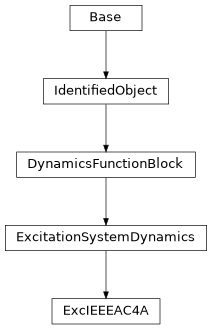cimpy.cgmes_v2_4_15.ExcIEEEAC4A module
- class cimpy.cgmes_v2_4_15.ExcIEEEAC4A.ExcIEEEAC4A(ka=0.0, kc=0.0, ta=0.0, tb=0.0, tc=0.0, vimax=0.0, vimin=0.0, vrmax=0.0, vrmin=0.0, *args, **kw_args)[source]
The class represents IEEE Std 421.5-2005 type AC4A model. The model represents type AC4A alternator-supplied controlled-rectifier excitation system which is quite different from the other type ac systems. This high initial response excitation system utilizes a full thyristor bridge in the exciter output circuit. The voltage regulator controls the firing of the thyristor bridges. The exciter alternator uses an independent voltage regulator to control its output voltage to a constant value. These effects are not modeled; however, transient loading effects on the exciter alternator are included. Reference: IEEE Standard 421.5-2005 Section 6.4.
- ka:
Voltage regulator gain (K). Typical Value = 200. Default: 0.0
- kc:
Rectifier loading factor proportional to commutating reactance (K). Typical Value = 0. Default: 0.0
- ta:
Voltage regulator time constant (T). Typical Value = 0.015. Default: 0.0
- tb:
Voltage regulator time constant (T). Typical Value = 10. Default: 0.0
- tc:
Voltage regulator time constant (T). Typical Value = 1. Default: 0.0
- vimax:
Maximum voltage regulator input limit (V). Typical Value = 10. Default: 0.0
- vimin:
Minimum voltage regulator input limit (V). Typical Value = -10. Default: 0.0
- vrmax:
Maximum voltage regulator output (V). Typical Value = 5.64. Default: 0.0
- vrmin:
Minimum voltage regulator output (V). Typical Value = -4.53. Default: 0.0
Documentation of parent class ExcitationSystemDynamics:
Excitation system function block whose behavior is described by reference to a standard model
- DiscontinuousExcitationControlDynamics:
Discontinuous excitation control model associated with this excitation system model. Default: None
- OverexcitationLimiterDynamics:
Overexcitation limiter model associated with this excitation system model. Default: None
- PFVArControllerType1Dynamics:
Power Factor or VAr controller Type I model associated with this excitation system model. Default: None
- PFVArControllerType2Dynamics:
Power Factor or VAr controller Type II model associated with this excitation system model. Default: None
- PowerSystemStabilizerDynamics:
Power system stabilizer model associated with this excitation system model. Default: None
- SynchronousMachineDynamics:
Synchronous machine model with which this excitation system model is associated. Default: None
- UnderexcitationLimiterDynamics:
Undrexcitation limiter model associated with this excitation system model. Default: None
- VoltageCompensatorDynamics:
Voltage compensator model associated with this excitation system model. Default: None
Documentation of parent class DynamicsFunctionBlock:
Abstract parent class for all Dynamics function blocks.
- enabled:
Function block used indicator. true = use of function block is enabled false = use of function block is disabled. Default: False
Documentation of parent class IdentifiedObject:
This is a root class to provide common identification for all classes needing identification and naming attributes.
- DiagramObjects:
The domain object to which this diagram object is associated. Default: “list”
- description:
The description is a free human readable text describing or naming the object. It may be non unique and may not correlate to a naming hierarchy. Default: ‘’
- energyIdentCodeEic:
The attribute is used for an exchange of the EIC code (Energy identification Code). The length of the string is 16 characters as defined by the EIC code. References: Default: ‘’
- mRID:
Master resource identifier issued by a model authority. The mRID is globally unique within an exchange context. Global uniqueness is easily achieved by using a UUID, as specified in RFC 4122, for the mRID. The use of UUID is strongly recommended. For CIMXML data files in RDF syntax conforming to IEC 61970-552 Edition 1, the mRID is mapped to rdf:ID or rdf:about attributes that identify CIM object elements. Default: ‘’
- name:
The name is any free human readable and possibly non unique text naming the object. Default: ‘’
- shortName:
The attribute is used for an exchange of a human readable short name with length of the string 12 characters maximum. Default: ‘’
Inheritance Diagram:
